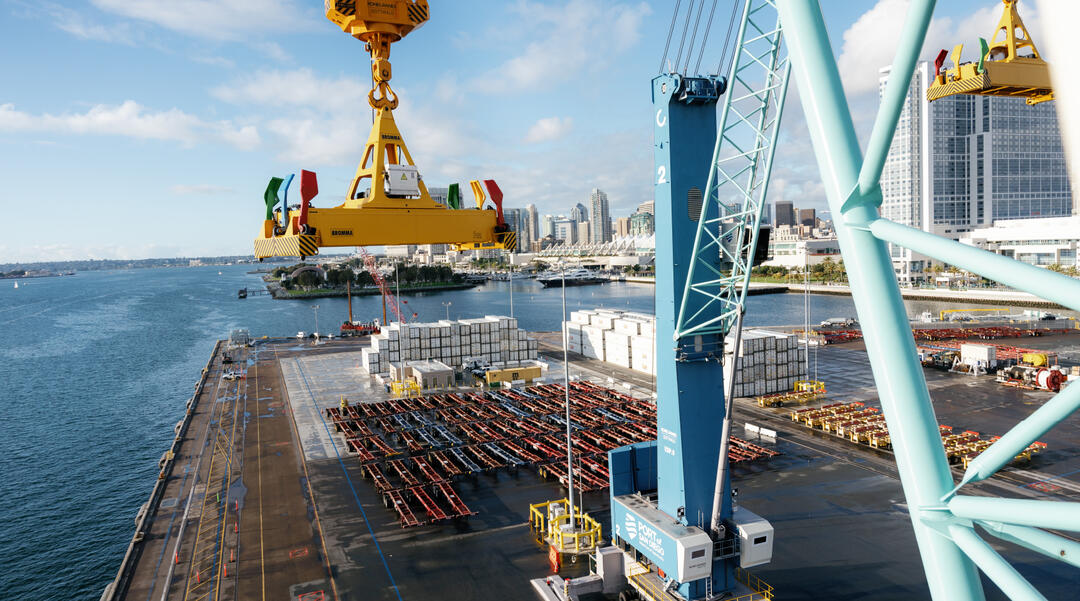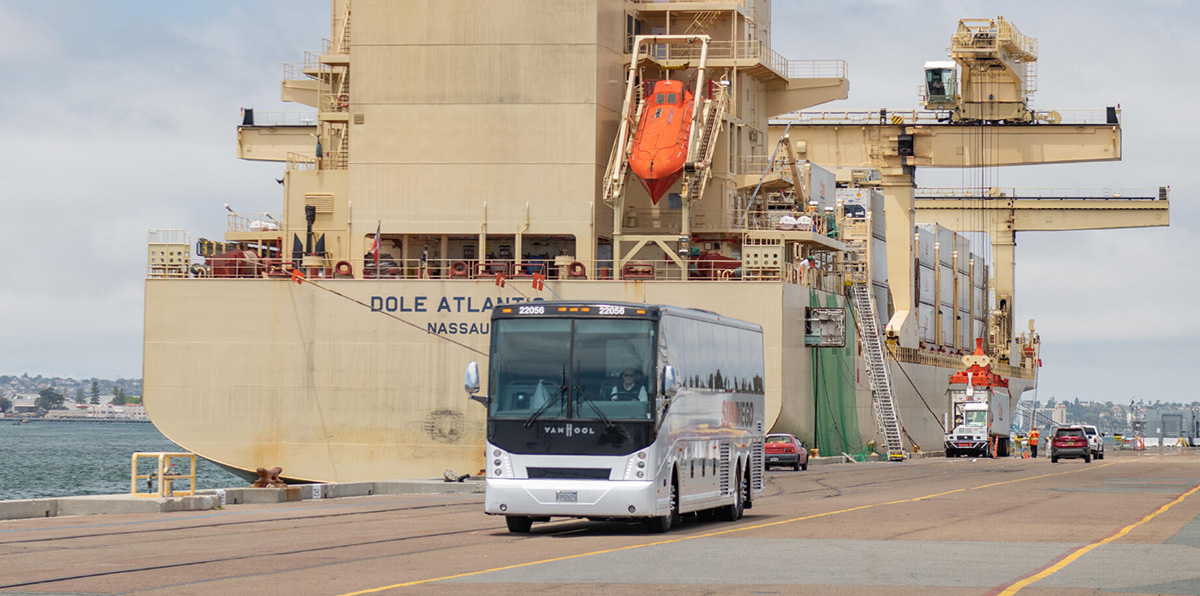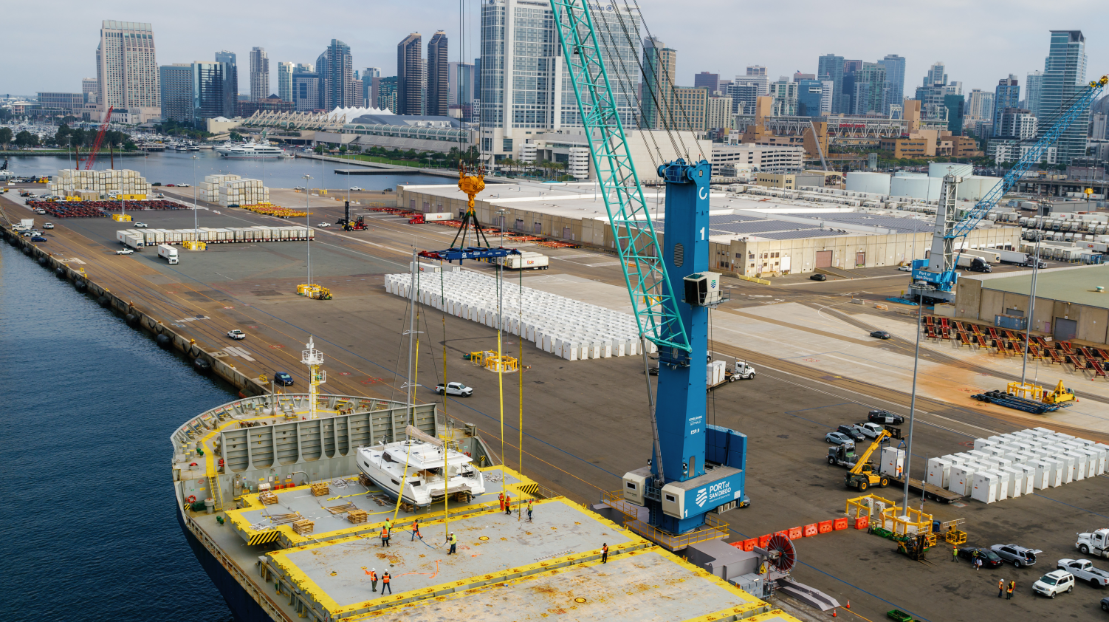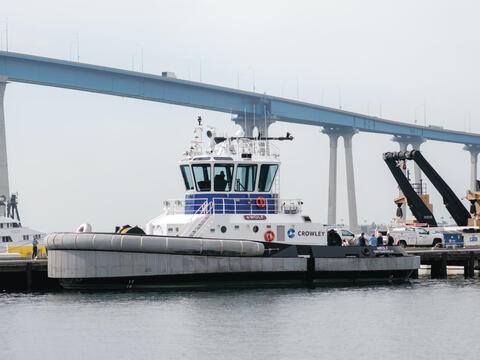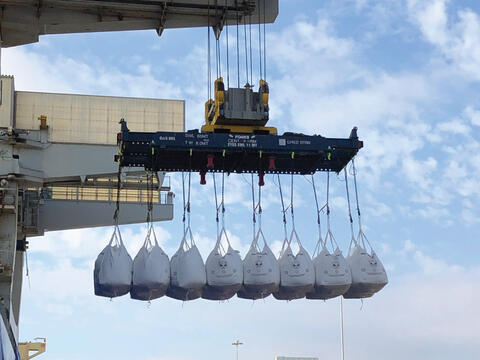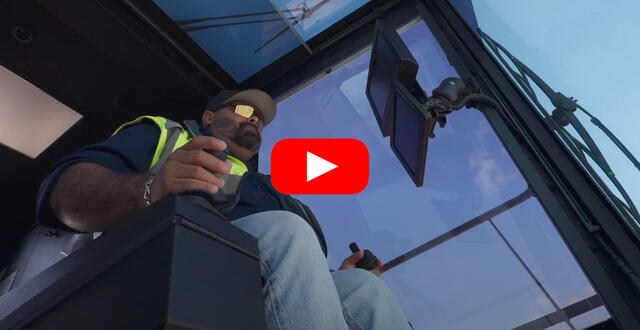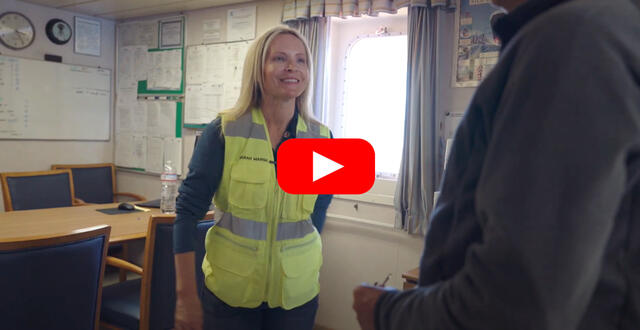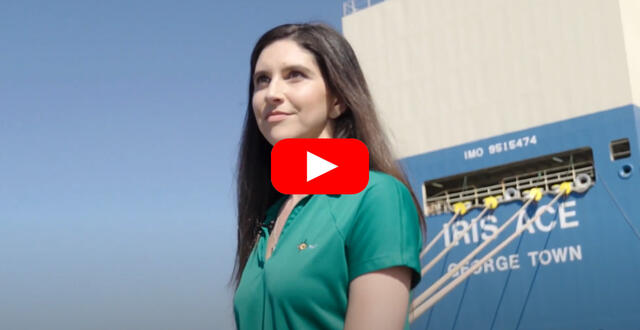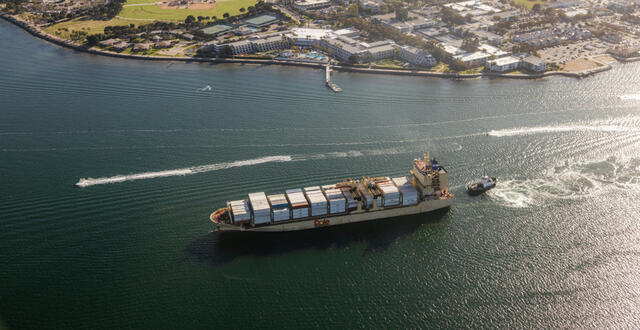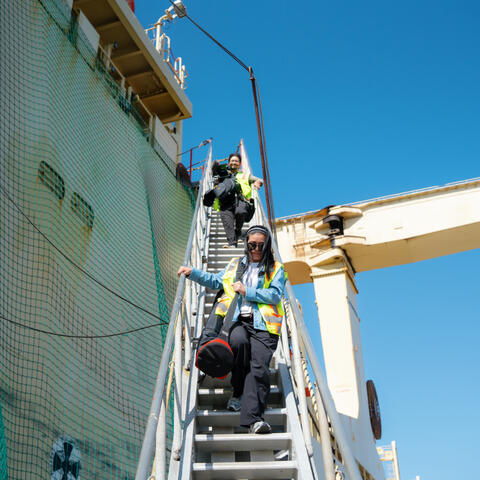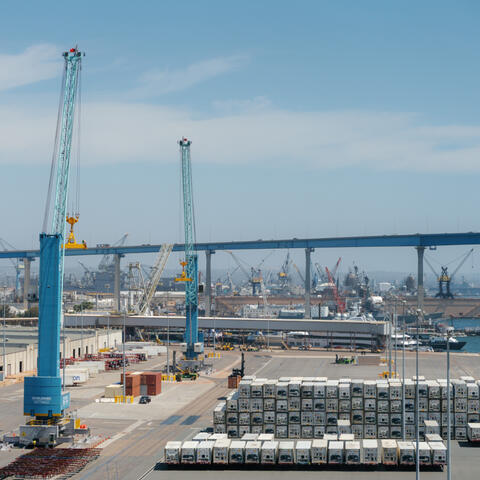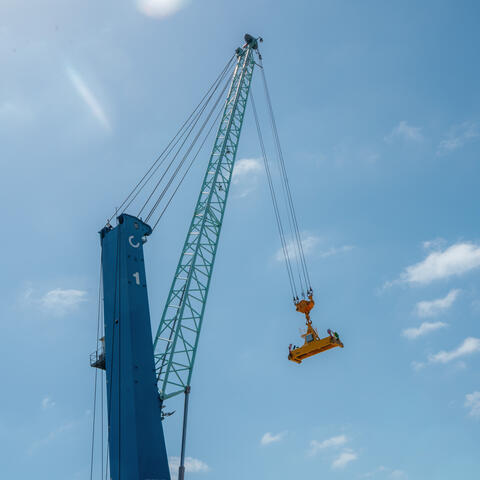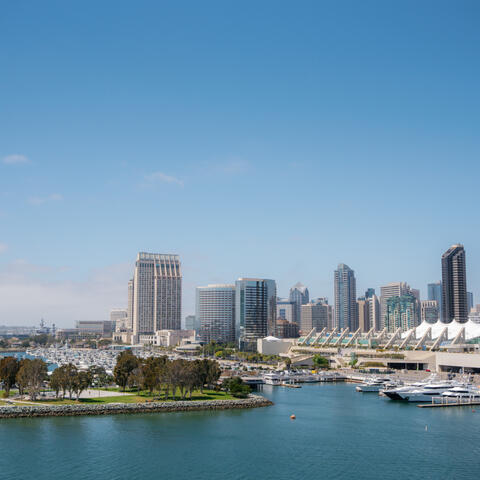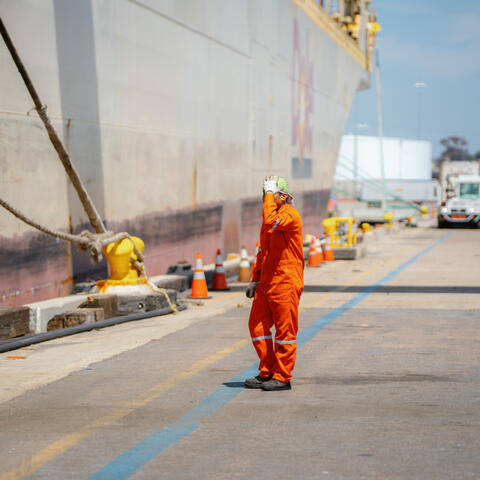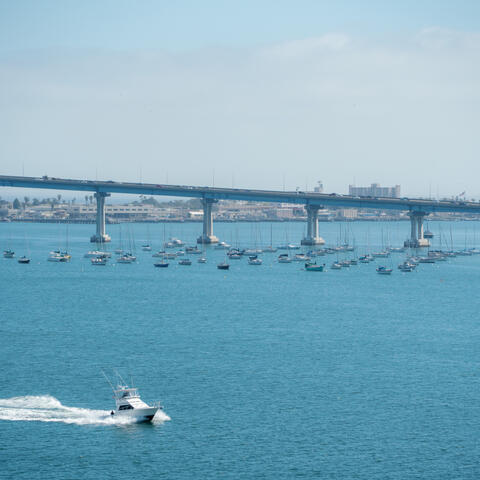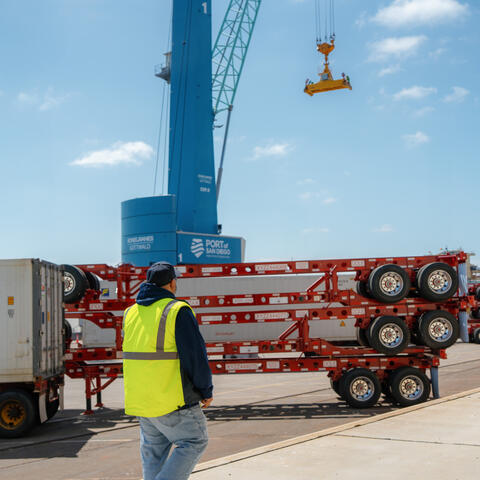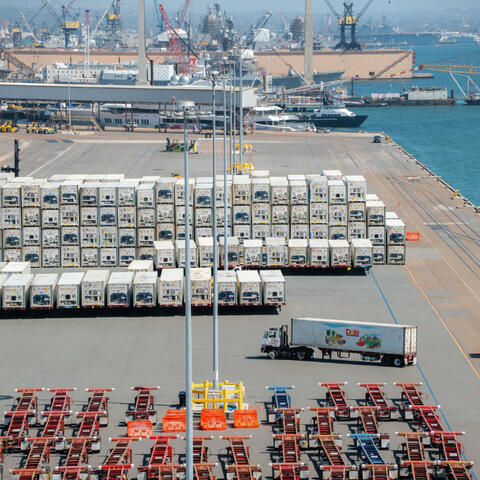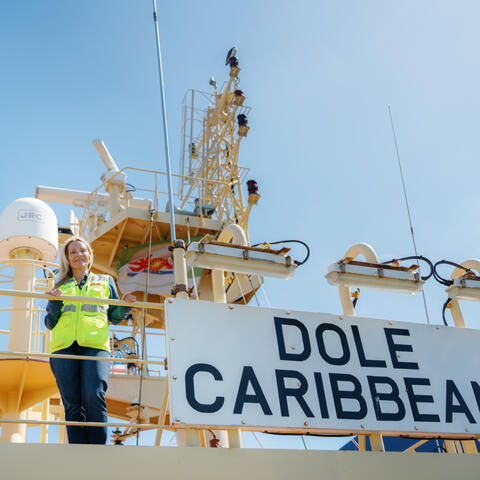Celebrating our bay of life
Throughout May, we are proud to celebrate the positive impacts of our maritime industry within the community and honor the thousands of valued employees working along our San Diego Bay waterfront.
Maritime Month Bus Tours
Throughout the month, we invited guests to experience the Port's cargo terminals and waterfront like never before with free to attend, 90-minute bus tours. Each of the tours were available on a first-come, first-served basis.
If you are interested in staying informed on future news, community events, and more, sign up for our emails!
Our Prosperous Bay of Life: The Four Sectors of Maritime
-
CargoCargoInterested in learning more about cargo?
In fiscal year 2024, the Port imported approximately 2,364,181 million metric tons of cargo. This included about:
- Approximately 362,000 vehicles (one in eight imported vehicles in the U.S. comes through the Port of San Diego)
- 658,044 metric tons of dry bulk cargo (sugar, sand, soda ash, fertilizer, bauxite, cement)
- 105,365 metric tons of break bulk cargo (project cargo, wind energy components, transformers and generators, and even yachts)
- 78,227 metric tons of liquid bulk cargo (jet fuel)
- 153,519 containers (in units – primarily refrigerated cargo like bananas, pineapples, and other fruits and veggies)
-
CruiseCruiseWant to plan your cruise?
A 2023 Economic Analysis Study found the Cruise Industry has a $184 million annual economic impact and provides nearly 500 jobs.
-
Shipbuilding and RepairShipbuilding and Repair
To help put the impact of our shipbuilding and ship repair sector into perspective, a 2023 Economic Analysis Study found the Industrial and Wholesale Industry, which includes shipbuilding and ship repair, has a $3.2 billion annual economic impact and provides about 7,169 jobs.
-
Commercial and SportfishingCommercial and SportfishingGet mariner resources here!
Commercial and sportfishing have a distinguished legacy within the San Diego Region and help nourish our way of life. At one time, San Diego was known as “The Tuna Capital of the World” with two of the countries three biggest tuna canneries based along our San Diego Bay.
As Sportfishing Association of California President, Ken Franke expresses, “Globally, San Diego is one of the largest sportfishing fleets of its kind in the world; San Diego offers live bait fishing, and we have hundreds of thousands of anglers who come down to San Diego’s boats each year."
A Global Economic Engine: Maritime
Maritime businesses provide thousands of San Diego residents with high-paying jobs and generate billions of dollars per year for the regional economy, creating a prosperous global economic engine for all.

Economic Impact Contributions based off 2023 Economic Impact Report.
To continue this prominent role within the San Diego region, each of our maritime sectors have been working towards an innovative and green way of life by implementing a variety of environmental initiatives; including but not limited to the first all-electric mobile harbor cranes in North America, the first all-electric tugboat in the United States, shore power expansion across all terminals, a bonnet system to collect cargo ship emissions, and the Vessel Speed Reduction Program.
Our Green Bay of Life: Environmental Work
-
Vessel Speed Reduction ProgramVessel Speed Reduction Program
The Vessel Speed Reduction Program is an objective of the Maritime Clean Air Strategy to lower the emissions of air pollutants and greenhouse gasses from cargo and cruise ships, by requiring reduced speeds in the vicinity of San Diego Bay. Reducing vessel speeds can decrease air emissions, which helps to combat climate change, protect marine life and improve air quality.
-
MicrogridMicrogridLearn More About Our Microgrid
The Port of San Diego initiated the Tenth Avenue Marine Terminal (TAMT) Microgrid - Resiliency in Terminal Operations project in 2016 with the objective of supporting the redevelopment and electrification of TAMT by making it a modern, clean, and more efficient terminal. This cornerstone project provides renewable, reliable, and resilient power to meet operational needs on TAMT and advances Port emissions reductions goals.
-
All-Electric TugboatAll-Electric Tugboat
In partnership with Crowley, the Port welcomes the eWolf, the first all-electric tugboat in the United States!
The 82-foot vessel with 70 tons of bollard pull advances Crowley and the maritime industry’s efforts toward sustainability and decarbonization. Over the first 10 years of its use, the new eTug will reduce 178 tons of nitrogen oxide, 2.5 tons of diesel particulate matter, and 3,100 metric tons of carbon dioxide versus a conventional tug. It also replaces a tugboat that consumes more than 30,000 gallons of diesel fuel per year.
The etug will operate from Crosby Pier at our Tenth Avenue Marine Terminal with it's battery system charged at a specially-designed shoreside station developed with Cochran Marine.
-
Bonnet SystemBonnet System
For vessels that are not able to utilize shore power, we are partnering with Clean Air Engineering – Maritime, Inc. (CAEM) to design, build, and operate a barge-based emissions control and capture system! This is sometimes referred to as a bonnet system.
This bonnet system is placed on top of a vessel’s smokestack and captures and treats exhaust while at berth. This system will be used for vessels that can’t utilize shore power.
-
Shore Power ExpansionShore Power Expansion
The Port first installed shore power at the cruise terminals in 2010, making us among the first ports in California to have shore power available for cruise ships.
Last year, we expanded the shore power capability at our B Street and Broadway Pier cruise ship terminals to allow two cruise ships to plug in simultaneously.
And now, we are adding a third connection at our cruise terminal that allows vessels with starboard connections to access shore power at the south berth. At our Tenth Avenue Marine Terminal, we currently have one shore power system, which is used by our tenant, Dole. We are also working on installing a shore power system at our National City Marine Terminal, which specializes in roll-on roll-off (ro-ro) cargo, that should be operational in the next year.
Shore power helps to improve air quality and reduce greenhouse gas emissions as ships do not have to run their diesel auxiliary engines while in port.
-
All-Electric Mobile Harbor CranesAll-Electric Mobile Harbor Cranes
Our new all-electric mobile harbor cranes are the first of their kind in North America and replace one of the biggest polluters in our maritime operations; the diesel-powered mobile harbor crane at the Tenth Avenue Marine Terminal.
In addition to public health and environmental benefits, these cranes also enable the Port to attract additional business opportunities due to the increased maximum lift capacity – up to 400 metric tons (MT) versus the 100 MT lifting capacity of the Port’s former diesel crane.
Maritime Fun Facts
When it comes to the relationship between our bay of life and maritime, there’s always something new to learn. Click through our timeline for a few fun facts!
Our new all-electric mobile harbor cranes have a total lift capacity of 400 MT (the heaviest lift capacity on the U.S. West Coast!). This means that our cranes do have the capabilities to handle heavy cargo like the depicted yacht!
When we talk about our all-electric mobile harbor cranes and their heavy lift, we’re referring to their ability to lift up to 400 metric tons (MT)! But what does that really mean? It means about 200 cars or (when our cranes are used in tandem) approximately 68 elephants!
...the Tuna Capital of the World! There’s even a historic statue commemorating our history as the homeport of the Pacific Tuna industry near Cesar Chavez Park.
Maritime Month is our region’s unique celebration of National Maritime Day.
In 1933, a Joint Congressional Resolution established May 22 as National Maritime Day to recognize the men and women of the U.S. Merchant Marine and the many other maritime industry workers who have transported cargo and defended the United States since 1775.
The Port of San Diego joins ports throughout the nation to celebrate this day and, as it has done for many years, the Port of San Diego extends Maritime Day into a month-long celebration.
While our beautiful bay sees many vessel types throughout the days, the vessel you’re looking at is the Crowley eWolf, the nation’s first all-electric tugboat!
Catch a trolley tour right in front of our cruise ship terminals and see multiple sites around San Diego Bay while waiting for your cruise ship to board!
You don’t have to look far to see how we’re living our green way of life! From our cruise terminals alone, you can see cruise ships plugging into our shore power and our new all-electric mobile harbor cranes right across San Diego Bay!
Bananas, sugar, and cars are just a few types of cargo which move through the Port’s Tenth Avenue Marine Terminal! A few other cargo types include aviation parts, bauxite, soda ash, steel, coils, transformers, windmill blades, towers, hubs and nacelles, and the list goes on!
You’re looking at bags of sugar and an example of the specialized care and attention to detail our terminals put into bulk cargo.
While our terminals can accommodate a wide variety of cargo types, we understand that not all cargo ships the same. Bananas for example, require special temperature-controlled storage containers to ensure a quality product upon delivery. Bulk commodities such as bauxite and sugar require an entirely different set of specialized equipment (a bulk loader and rail with bulk capabilities) to ensure a quality product upon delivery!
The Port of San Diego is one of 18 commercial Strategic Ports designated by the U.S. Department of Transportation in support of the U.S. Department of Defense.
As part of our voluntary Vessel Speed Reduction Program, participating vessels reduce their speed as they enter the vicinity of San Diego Bay.
Cargo ships reduce their speed to no more than 12 knots and cruise ships reduce their speed to no more than 15 knots!
Did you know that one in every EIGHT cars nationwide gets processed through our cargo terminals? In fiscal year 2024, the Port imported approximately 362,000 vehicles!
Every year, our commercial and sportfishing sector yields approximately 5 million lbs. of fish!
Our Bay of Life: Stories & Highlights
Join us as we celebrate the stories that connect maritime to the community.

